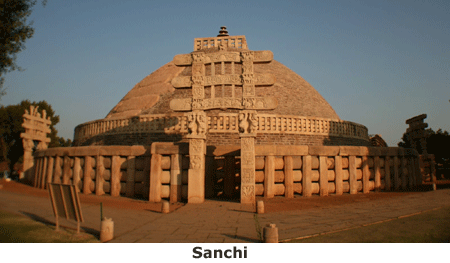SANCHI................................................................................................................................................................................................................................................................................... Sanchi, variously known as Kakanaya, Kakanava, Kakanadabota and Bota-Sriparvata in ancient times, has a singular distinction of having remarkable specimen of Buddhist art and architecture right from the early Mauryan period (c. third century BC to twelfth century AD). Sanchi is famous in the world for stupas, monolithic Asokan pillar, temples, monasteries and sculptural wealth. It was Emperor Asoka who laid the foundations of a religious centre at Sanchi fascinated probably by the location of the hill or because of his Queen Devi, who was the daughter of a merchant of Vidisha. He erected the Great Stupa (Stupa 1) here after redistribution of mortal remains of Lord Buddha for erecting several stupas all over the country in order to spread Buddhism. This stupa was originally a low structure of brick, half the diameter of the present edifice hemispherical in shape with raised terraces at the base. It was enclosed by a wooden railing and a stone umbrella at the top. This Great Stupa served as a nucleus to the large Buddhist establishment during the later period. During Sunga times, several edifices were raised at Sanchi and its surrounding hills. The Asokan stupa was enlarged and faced with stones and decorated with balustrades, staircases and a harmika on the top. In the first century BC the Andhra-Satavahanas,
who had extended their sway over the eastern Malwa, caused the elaborately
carved gateways to Stupa 1. The Great Stupa of Sanchi displays an austere
grandeur and the exquisite carvings of the doorway depict in detail the
significant episodes and miracles from Lord Buddha’s life and events
depicted in the Buddhist Jataka stories. From the second to fourth century AD Sanchi and Vidisha came under the Kushanas and Kshatrapas and subsequently passed on to the hands of the Guptas. During the Gupta period some temples were also built and sculptures were added displaying the classical grace and simplicity of the era. Further, statues of Lord Buddha seated in the canopies facing the four entrances of the Great Stupa were also added. Sanchi also flourished during the 7th – 12th centuries A.D. when shrines and monasteries were continued to be added. Thus Sanchi displays harmonious co-existence of Hindu and Buddhist faiths. Since the fourteenth century Sanchi remained deserted and uncared for till 1818 when General Taylor rediscovered the site. Sir John Marshall established an archaeological museum in 1919, which was later transformed into the present site museum at Sanchi. Presently under an UNESCO project Sanchi and Satdhara, a Buddhist site, 10 km south-east of Sanchi, is being further excavated, conserved and environmentally developed. |
|||||||
|
|
|||||||




